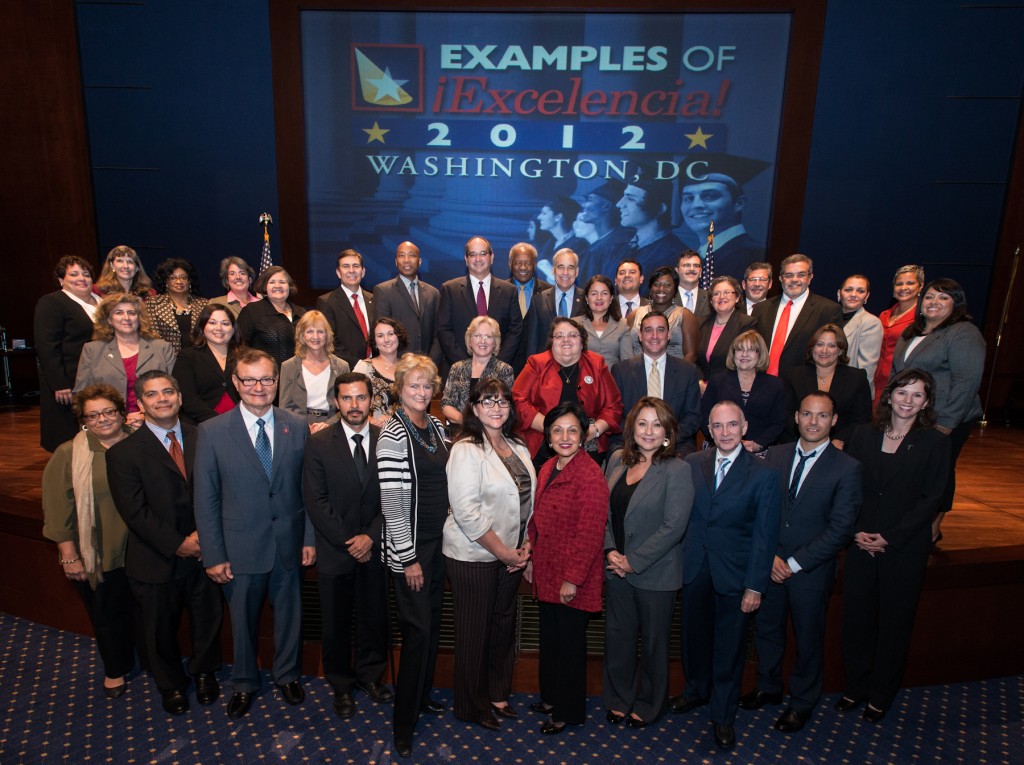
The Encounter To Excellence (ETE) Program, or Encuentro Hacia El Exito, at California State University, Dominguez Hills was recognized for its work to accelerate Latino student success in higher education and–out of nearly 200 nationwide submissions from associate, baccalaureate, and graduate programs–was selected as a finalist for the 2012 Examples of ¡Excelencia! at the baccalaureate level by Excelencia in Education.
“We were among the 16 that were recognized as clear examples in Excelencia,” said William Franklin, associate vice president of Enrollment Management and Student Affairs, and ETE program director.
On behalf of CSU Dominguez Hills, Franklin, along with Paz Oliverez, coordinator of the ETE program, accepted an award from Examples of ¡Excelencia! and Congresswoman Laura Richardson during the Celebración de Excelencia held in Washington, D.C., on Oct. 2.
The ETE program was also profiled in the Examples of ¡Excelencia! “What Works for Latino Students in Higher Education” 2012 compendium, which is widely distributed online and in print to more than 16,000 of Excelencia in Education constituents, including key educational organizations and policy leaders. Additionally, the university’s program has been included in the Growing What Works database.
In its fourth year of a five-year federally funded Title V Hispanic Serving Institution Initiative, the ETE program will see its first graduates in 2014 and now serves nearly 500 students. Franklin said the program, which offers supplemental instruction, peer mentoring and proactive academic advising, has had an impact, and data collected since the first cohort was admitted in 2009 backs that up.
The main goal of ETE is to ensure a successful freshman year for those entering students who although they meet CSU admission eligibility, scored in the lowest quartile on the CSU-standardized English Placement Test (EPT) and Entry Level Mathematics (ELM) exam. And the data Franklin points to shows that the cohorts are experiencing success and are more likely than their peers to continue their studies. Of the 104 students in the initial 2009 ETE cohort, 86 percent were retained, a 20 percent increase when compared to retention rates of other students requiring developmental courses. They also earned GPAs that were approximately .20 to .40 points higher than the general population of freshmen. After two years, the ETE cohort retention rate achieved 75 percent compared to 59 percent for the rest of the general freshman population.
The 2010 cohort of 180 students continued an upward trend in one-year retention rates at 94 percent, and their GPAs continued to be approximately .20 to .40 points higher after their first and second semesters.
And with the 2011 ETE cohort, the retention rate was 98 percent and the average GPA was 3.0, compared to 2.74 earned by freshman outside the program.
Making these numbers more impressive is that more than 85 percent of the students in the ETE program are low-income and close to 78 percent are first-generation students, who typically experience more challenges in getting into and staying in college.
“That says a lot and that’s one of the reasons Examples of ¡Excelencia! recognized our program,” Franklin said.
Franklin noted that nationally, the focus is on retention and graduation, rather than access alone, and that the level of consistent student performance points significantly toward their success in earning a degree. He said indicators of promising performance among ETE students during the critical first and second year in college are having a GPA of 2.8 or higher, completing a sufficient number of units, and whether students complete developmental education within their first year.
“Number one, we want to see our students persisting. Persistence is a way of looking at how well students are doing year after year,” Franklin said.
As part of the Celebración de Excelencia, Franklin and Oliverez attended a day-long Accelerating Latino Student Success workshop to share ideas and best practices with educational, policy, government, philanthropic and Latino advocacy leaders from across the country who are championing effective strategies for Latino college student success.
“As we shared our processes and outcomes for a robust first and second year Bridge initiative, we learned, across the nation, that the earlier you get students into not only internships, but also research opportunities with faculty–it just pays off,” Franklin said. “Our initiative and the stellar work occurring nationally with first generation students dovetails well and are in concert with what [University Interim President Hagan] is promoting with his student success initiative.”
A major component of the ETE program–the Bridge program, which stewards students through a summer and first year developmental math and English program, is an objective to scale up to include all incoming freshmen who require additional courses to bring them to college-level proficiency. This is made possible in part by a $250,000 grant from the Rosalinde and Arthur Gilbert Foundation, allocated over two years.